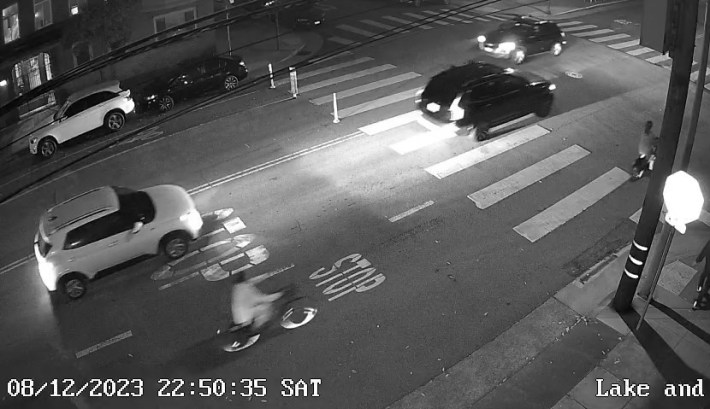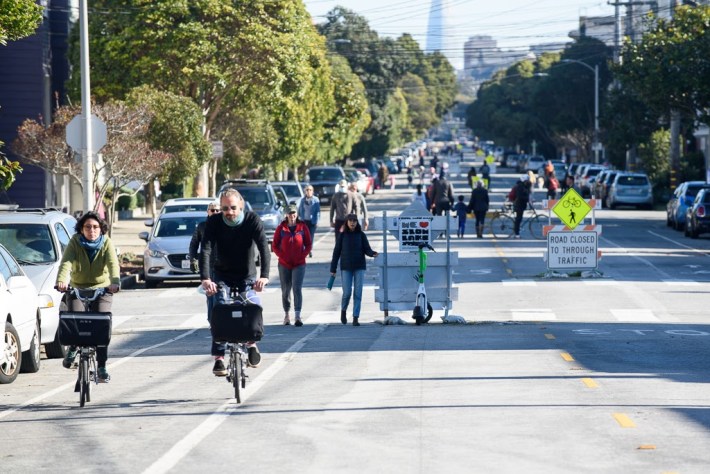Note: GJEL Accident Attorneys regularly sponsors coverage on Streetsblog San Francisco and Streetsblog California. Unless noted in the story, GJEL Accident Attorneys is not consulted for the content or editorial direction of the sponsored content.
Over 2,000 motorists drove down Lake Street every day on the week of December 5. And over half of those motorists exceeded SFMTA's 15 mph "target speed," according to data provided by citizen advocates to Streetsblog. Counts that high are typical on Lake, which is supposed to be a "slow street" with limited traffic volumes.
The street is also used by many cyclists and scooterists, including kids going to school. Locals warn the situation is growing increasingly dangerous.
"There are countless incidents and close calls," said Katherine, a safety advocate and resident of Lake Street. "Even if a driver is going slow, another driver will aggressively pass them on Lake."

Katherine, who asked Streetsblog to withhold her last name for fear of retaliation from her motorist-neighbors, said that the SFMTA slow streets program, as implemented, just isn't working on Lake. It's also plagued by nastiness and aggression. As Streetsblog has reported previously, motorists who use Lake sometimes threaten to run people over. Someone even cut the pneumatic sensor strips that collect data on passing cars and motorist speeds.

Lake Street was approved by the SFMTA board as a permanent slow street back in December of 2022, along with 15 other streets. These streets were originally modified using simple planters, signs, and artwork during the pandemic to limit automobile traffic and speeds to allow cyclists, scooterists, and pedestrians to safely share the space. Prior to the vote, a slow street designation also meant a ban on through traffic. However, SFMTA staff authorized the removal of the "no through traffic" signs even as the debate raged in the SFMTA board room about what would constitute a slow street. Advocates warned that allowing through traffic would result in a return of cut-through traffic and speeding.

The agency installed little purple signs on plastic posts instead (see above), which do not work to limit motorist speed and volume on Lake (as explained in the Tweet below from "Friends of Slow Lake Street).
A year ago Slow Lake was made permanent.@SFMTA_Muni imposed a 1,000/vehicle a day ceiling.
— Friends of Slow Lake Street❤️🚶♀️🧑🏻🦼🚴🏾♂️🚎 (@SlowLakeStreet) December 14, 2023
If car volume exceeded that, new infrastructure was supposed to go in.
Today we blow past that limit by *hundreds* of cars every weekday.
Why have rules if we don’t enforce them? pic.twitter.com/qCkZQzJHOp
As referenced in the Tweet, SFMTA Director Jeffrey Tumlin and his staff promised that if car-counts were high and their 15 mph target speed was exceeded, new infrastructure would go in.
"When we reviewed Lake earlier this year, median speeds were 17 mph and daily volumes of 820 vehicles averaged across the entire corridor," wrote SFMTA's Erica Kato, in an email to Streetsblog. "We continue to be interested in what Telraam data can offer us, as any traffic count is a snapshot in time, but we only make decisions from official SFMTA-commissioned traffic studies."
Kato is referring to traffic data acquired by advocates on Lake using Telraam, a type of crowd-sourced traffic data that uses computers with cameras aimed out of house windows at the street to count passing vehicles. That data clearly shows Lake, at this point, is only a slow street on paper. A recent post by KidSafeSF which consolidated such data on Lake and other streets also found that "On most weekdays, Lake Street exceeds the vehicle volume target."

However, Telraam's system doesn't work after dark and is therefore considered less reliable than pneumatic tubes, the traditional way traffic counts are made. The tubes are activated by the weight of a passing car's tires. The older method works better in winter when there are fewer hours of daylight.
But Katherine and other Slow Lake advocates hired Idax Data, the same contractor SFMTA uses, to place pneumatic tubes as a second source of car counts and speeds. "We did that in part to compare the Telraam data, in part to get a more complete picture."

These more complete and far more recent counts by advocates show that around 2,000 cars drive down Lake daily, or twice the amount that was supposed to trigger physical safety measures on the street.
So if advocates are using the same contractor to count cars, why does SFMTA have lower counts? Katherine can't find any data from SFMTA before January of 2023, which appears to be the last time they counted cars on Lake. That, of course, was shortly after SFMTA removed the old "no through traffic" signs. Over time, advocates opined to Streetsblog, drivers realized there's no longer any deterrent to speeding down Lake.
SFMTA's Kato wrote that "new purple signs will be installed along the corridor soon, helping to communicate that Lake is a slow street and not the best route for getting across the neighborhood. We will continue to monitor conditions to inform possible further next steps." It's unclear what the next steps or additional signs will look like (Streetsblog asked Kato but received no reply). New "Slow Streets" signs installed on Page Street were put on the sidewalk, where they're unlikely to be effective, as seen below:

As mentioned, SFMTA originally promised additional infrastructure would be placed on Lake if speed and the number of cars exceeded thresholds. Clearly, going by the most recent data, gathered by Telraam and pneumatic tubes, that's happened. And yet SFMTA has taken no action. "You need a physical barrier," said Katherine.

Advocates say the close calls and aggressive, dangerous driving is happening every day, despite SFMTA director Tumlin's appeals for "civility." Katherine provided pictures of a motorist driving in the bike lane, close behind a man biking with his two little girls, seen in the above image. The driver followed "him all the way up the bike lane." She said that's typical.
She is terrified that a child riding a bike or scooter will get run over by a speeding motorist. Only then will SFMTA make good on its promise to install the physical diverters and concrete infrastructure that should have been there the whole time to inhibit unsafe driving. If such a tragedy passes, Katherine wants to make sure SFMTA officials are held accountable. "If nothing else, I'm making a record that SFMTA knew exactly how bad it has become," she told Streetsblog. "They know their transportation code is egregiously violated but they're not doing anything about it."





